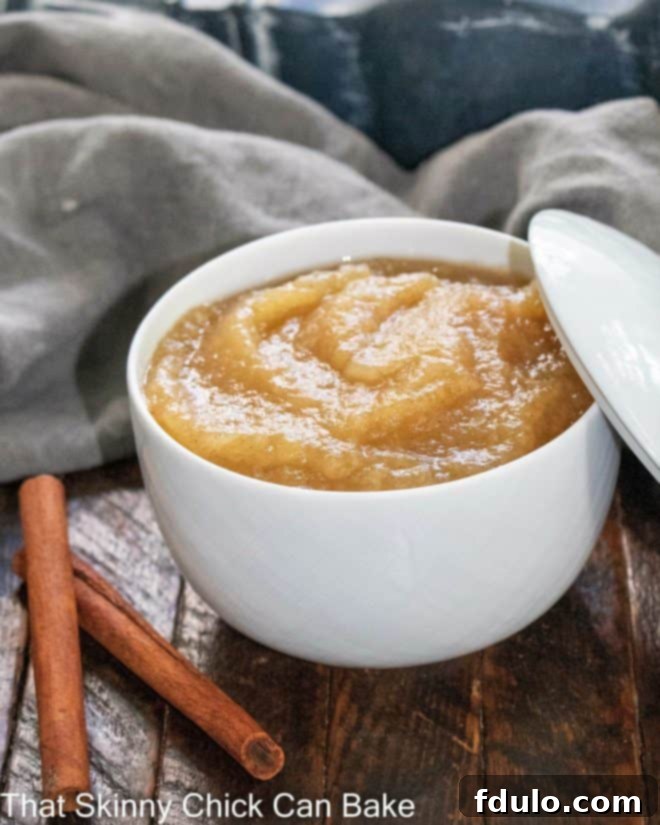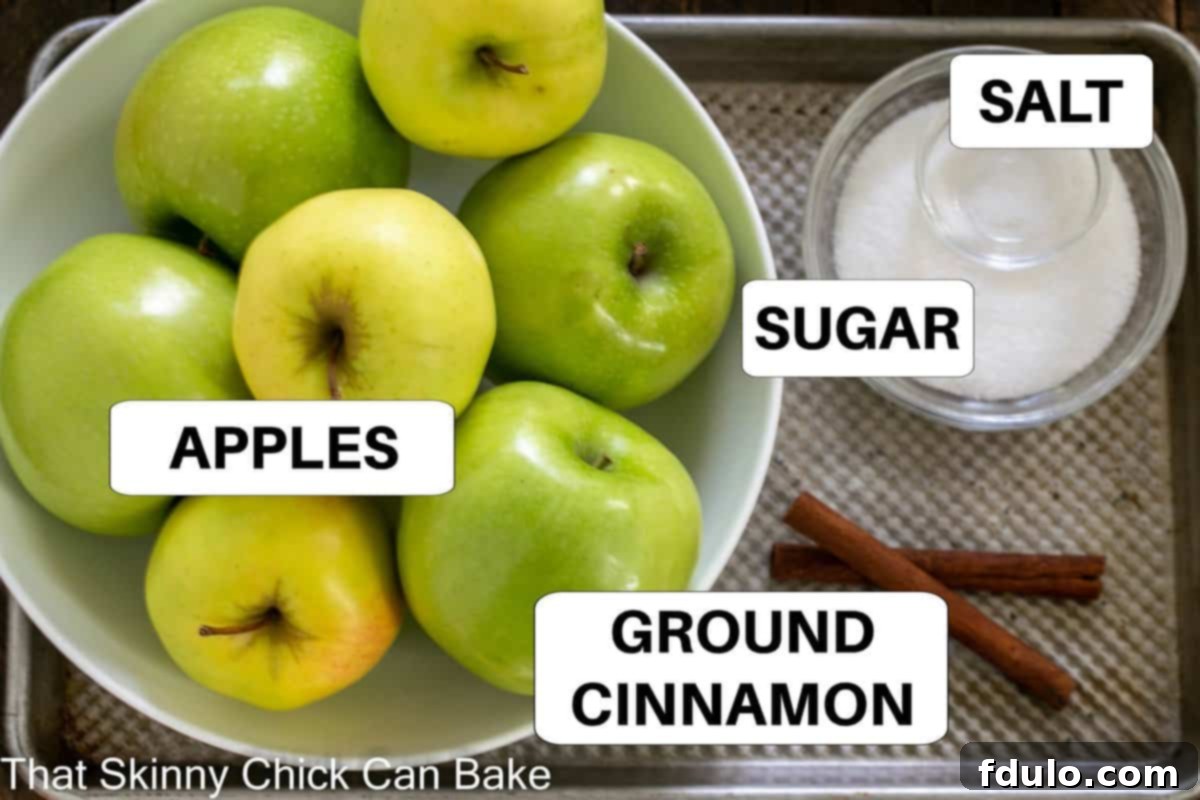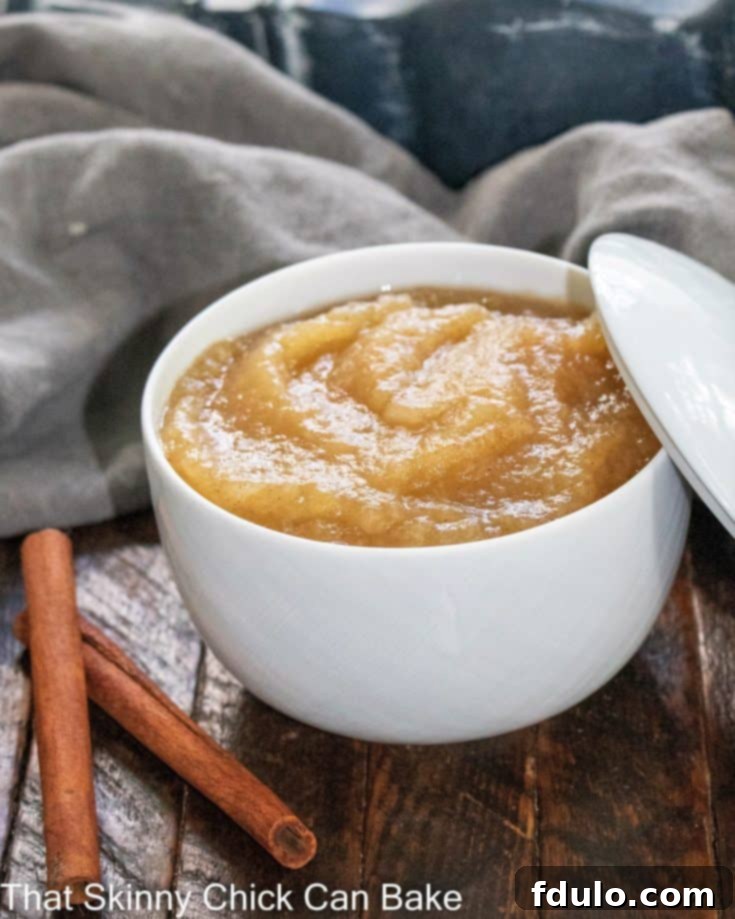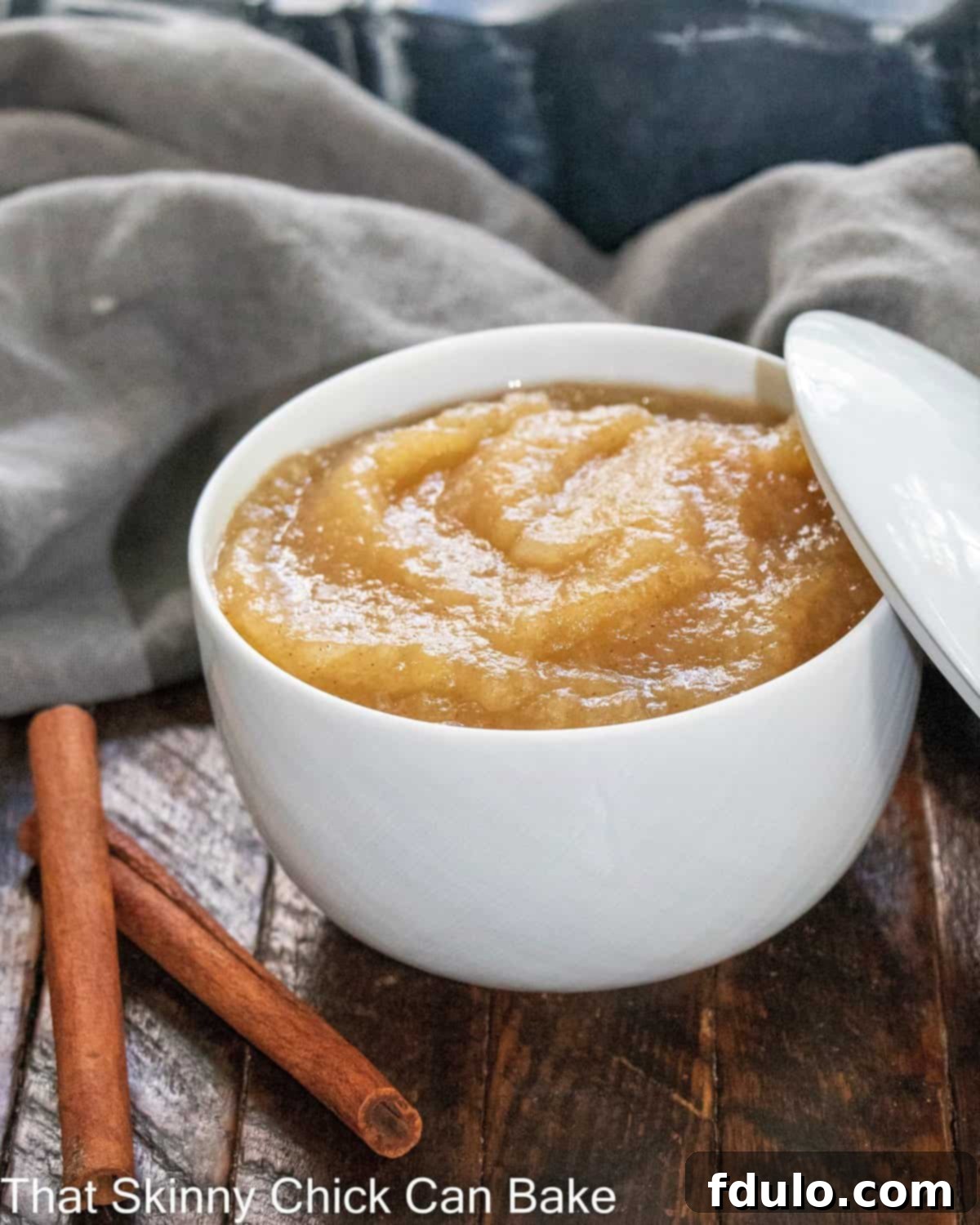Homemade Applesauce is an undeniable autumn delight, filling your kitchen with an aroma that speaks of crisp air and cozy evenings. This incredibly easy Cinnamon Spiced Applesauce recipe is not only simple to prepare but also perfectly adaptable to your unique taste preferences, allowing you to create a batch that’s just right for you and your family. Forget store-bought versions laden with unwanted additives; embrace the pure, wholesome goodness of apples transformed into a comforting classic.

Why Homemade Applesauce is a Must-Make
There’s a special magic that comes with making applesauce from scratch. It’s more than just a recipe; it’s an experience that engages your senses and nourishes your body. Here’s why diving into the world of homemade applesauce is absolutely essential:
- Simple, Wholesome Ingredients: The beauty of this recipe lies in its simplicity. You only need a handful of basic ingredients: fresh apples, a touch of water, a pinch of salt, your preferred sweetener, and a generous dash of cinnamon. No need for artificial flavors, preservatives, or high-fructose corn syrup often found in commercial brands.
- Tailored to Your Taste: This recipe offers unparalleled flexibility. Do you prefer your applesauce naturally sweet with minimal added sugar? Choose sweeter apple varieties. Are you a cinnamon enthusiast who loves a bold, spicy kick? Feel free to double or even triple the amount. If you crave a hint of tang, a squeeze of fresh lemon juice will do the trick. The power to customize is entirely in your hands.
- Pure Goodness, No Additives: Say goodbye to cryptic ingredient lists. When you make applesauce at home, you control every single component. This means no corn syrup, no artificial colors, and no unpronounceable chemicals. Just pure, unadulterated fruit goodness for you and your loved ones.
- Aromatic Bliss: As the apples simmer on your stove, they release an incredibly inviting aroma that permeates your entire home. The sweet, spicy scent of cinnamon and cooked apples is the quintessential fragrance of autumn, creating an atmosphere of warmth and comfort that store-bought versions simply can’t replicate.
- Cost-Effective & Eco-Friendly: Making applesauce at home can often be more economical, especially when apples are in season or purchased in bulk. It also allows you to utilize apples that might be slightly bruised or imperfect, reducing food waste and making the most of your produce.
- A Healthy Choice: By controlling the sugar content, you can easily create a healthier version of applesauce. For those looking to reduce sugar intake, selecting naturally sweeter apples can minimize or even eliminate the need for added sweeteners. Apples themselves are packed with fiber, vitamins, and antioxidants, making homemade applesauce a nutritious snack or side dish.
Whether you prefer a chunky, rustic texture or a silky-smooth puree, this recipe is designed to be easily adapted. I personally find that a blend of two distinct apple varieties offers a more complex and satisfying flavor profile, but any good cooking apple will yield delicious results.

Key Ingredients and Their Role
Crafting the perfect batch of homemade applesauce starts with understanding the role each ingredient plays. While the list is short, the quality and type of each component can significantly influence the final flavor and texture.
- Cooking Apples: The foundation of your applesauce! For a truly nuanced flavor, I highly recommend using a combination of apple varieties. My go-to pairing is 4 Granny Smiths (for their tartness and firm texture, which helps prevent mushiness too quickly) and 4 Golden Delicious (for their inherent sweetness and softer consistency). Other excellent choices include Fuji, Honeycrisp, Gala, McIntosh, Jonagold, Jonathan, and Cortland. Experiment to find your favorite blend! A mix of sweet and tart, firm and soft apples will give your applesauce depth and character that a single variety often lacks.
- Water: This essential liquid serves multiple purposes. It creates steam in the pot, which helps the apples cook down evenly and soften without scorching. It also contributes to the initial liquid content, preventing the apples from sticking to the bottom of the pan as they release their own juices. The exact amount can be adjusted based on the juiciness of your apples.
- Sugar: White granulated sugar is typically used, but the amount is entirely up to your taste and the sweetness of your chosen apples. You can start with less and add more later. For a healthier or sugar-free option, use naturally sweeter apples and skip the added sugar, or consider natural alternatives like honey or maple syrup if desired, adjusting for liquid content.
- Salt: Often overlooked in sweet recipes, a small pinch of salt is a powerful flavor enhancer. It brightens the natural sweetness of the apples and balances the overall flavor profile, preventing the applesauce from tasting flat or one-dimensional. Don’t skip this humble but mighty ingredient!
- Cinnamon: The star spice of this recipe, adding warmth and a classic autumn flavor. Ground cinnamon is convenient, but for an extra layer of flavor and aroma, consider adding a cinnamon stick or two to the pot while the apples cook. This allows the spice to infuse slowly, creating a deeper, more rounded cinnamon essence. You can remove the sticks before mashing.
- Lemon Juice (Optional but Recommended): A splash of freshly squeezed lemon juice is a secret weapon in applesauce making. If your applesauce ends up overly sweet or you’ve used very sweet apples, lemon juice provides a crucial acidic balance, brightening the flavors and cutting through the richness. It also helps prevent the apples from browning too much during cooking and storage, preserving their vibrant color.
Optional Flavor Enhancers:
While the classic cinnamon applesauce is divine on its own, don’t hesitate to experiment with other spices and flavorings to create unique variations:
- Nutmeg or Allspice: A small pinch can add extra warmth and complexity.
- Vanilla Extract: A teaspoon added at the end of cooking can elevate the sweetness and aroma.
- Orange or Lemon Zest: Grated zest from citrus fruits can add a bright, fragrant note.
- Cloves: A couple of whole cloves added during cooking, then removed, can provide a rich, aromatic undertone.
How to Make the Best Cinnamon Spiced Applesauce
Making homemade applesauce is surprisingly straightforward, requiring minimal effort for maximum reward. Follow these simple steps to create a batch of fragrant, delicious applesauce that will become a family favorite.

- Prepare the Apples: Begin by peeling, coring, and slicing or chopping your chosen apples. Aim for relatively uniform pieces, about 1-inch chunks, to ensure even cooking. The smaller the pieces, the faster they will cook down.
- Combine and Cook: Place the prepared apple slices into a large, heavy-bottomed pot or Dutch oven. Add the water, sugar (start with about half of the recommended amount if you prefer less sweetness, you can always add more later), and a pinch of salt. Stir everything together to combine. Cover the pot with a lid and bring the mixture to a gentle simmer over medium heat.
- Softening the Apples: Once simmering, reduce the heat to low-medium and continue to cook, stirring occasionally. The apples will gradually soften and break down. This process typically takes between 15-25 minutes, depending on the apple variety and the size of your pieces. You’ll know they’re ready when they are fork-tender and easily mashable.
- Mash to Desired Consistency: Once the apples are perfectly soft, remove the pot from the heat. Using a potato masher, mash the apples directly in the pot to your desired consistency. For a chunky applesauce, mash lightly, leaving some discernible pieces of fruit. For a smoother texture, mash more vigorously. If you prefer a completely velvety puree, you can transfer the mixture to a food processor or use an immersion blender until smooth.
- Season and Adjust: Now is the time to add your cinnamon. Start with about ½ teaspoon and stir it in thoroughly. Taste the applesauce. This is your opportunity to fine-tune the flavors. If it’s not sweet enough for your liking, add more sugar, a tablespoon at a time, until it’s perfect. If you desire a stronger cinnamon flavor, add another ¼ to ½ teaspoon. If the applesauce tastes too sweet, a small squeeze of fresh lemon juice will help balance it beautifully.
- Cool and Store: Allow the applesauce to cool completely before transferring it to airtight containers. It can be stored in the refrigerator for up to 7-10 days or frozen for several months.
Expert Tips for the Best Homemade Applesauce
Elevate your applesauce game with these insightful tips, ensuring every batch is a resounding success.
- Embrace Apple Variety: As mentioned, using at least two different types of apples is a game-changer for flavor. Combining sweet, softer varieties like Golden Delicious or Fuji with firm, tarter apples such as Granny Smiths or Honeycrisps creates a complex and well-rounded taste that’s simply irresistible. The contrasting textures also add interest.
- Control Your Sweetness (and Avoid Unwanted Additives): Store-bought applesauce often contains both high fructose corn syrup and regular corn syrup, along with other preservatives. Making your own allows you to use granulated white sugar sparingly, or even skip it entirely if you opt for naturally sweet apples. This control over sweetness is not only healthier but also ensures a cleaner, more natural flavor.
- Customize the Texture: The beauty of homemade is choosing your perfect texture. For young children, a smooth, pureed consistency is often preferred. A food processor or immersion blender can achieve this easily. As palates mature, many enjoy a chunkier, more rustic applesauce, which can be achieved with a simple potato masher, leaving some delightful apple pieces intact. Don’t be afraid to adjust based on your family’s preferences.
- Don’t Overcook: While you want the apples to be very soft, avoid boiling them too aggressively or for too long. Overcooking can lead to a slightly burnt taste or a thin, watery applesauce if too much liquid evaporates too quickly. A gentle simmer is key.
- Patience with Seasoning: Always taste and adjust your seasonings (sugar, cinnamon, lemon juice) at the end of the cooking process. The flavor of apples can change as they cook down, so what seems right initially might need tweaking later.
- Storage Solutions: Properly stored homemade applesauce can be kept in an airtight container in the refrigerator for up to 7-10 days. For longer storage, it freezes beautifully. Portion it into freezer-safe containers or bags, leaving a little headspace for expansion. It can last for 3-6 months in the freezer. Thaw in the refrigerator overnight before serving.
- Consider a Slow Cooker: For a hands-off approach, you can make applesauce in a slow cooker! Simply combine all ingredients in the slow cooker and cook on low for 4-6 hours or on high for 2-3 hours, until apples are tender. Then mash as desired.
How to Use Homemade Applesauce Beyond the Spoon
Your freshly made applesauce is incredibly versatile and can be enjoyed in countless ways, far beyond just eating it with a spoon.
- A Perfect Side Dish: Applesauce is a classic accompaniment, especially in the fall and winter months. It pairs wonderfully with savory dishes like roasted pork, grilled chicken, or even a hearty breakfast of sausage and eggs. Its sweet and tart notes cut through rich flavors, offering a refreshing contrast.
- Wholesome After-School Snack: Serve it chilled or slightly warm as a healthy, satisfying snack for kids and adults alike. It’s a fantastic alternative to processed snacks and provides a good boost of fiber and natural energy.
- Baking Substitute: Applesauce is a baker’s secret weapon! It can often be used as a healthier substitute for oil or butter in muffins, cakes, and quick breads, adding moisture and reducing fat content. It can also partially replace sugar in some recipes, especially if your applesauce is naturally sweet.
- Delicious Breakfast Booster: Stir a generous dollop into your morning oatmeal, Greek yogurt, or spread it on pancakes and waffles instead of syrup. It adds natural sweetness, flavor, and nutrition to your breakfast routine.
- Elevate Desserts: Use your homemade applesauce to fill delectable pastries like Chaussons aux Pommes (French apple turnovers) or as a topping for vanilla ice cream or pound cake. It also makes a fantastic base for apple crisps or crumbles.
- Marinade Ingredient: Its acidity and sweetness make it a great addition to marinades for poultry or pork, helping to tenderize the meat and infuse it with fruity flavor.
Frequently Asked Questions About Homemade Applesauce
For the best results, use a combination of apple varieties. I personally love a mix of tart and firm Granny Smiths with sweet and softer Golden Delicious apples. Other excellent choices include Fuji, Honeycrisp, Gala, MacIntosh, Jonagold, Jonathan, and Cortland. Combining two or more varieties creates a more complex and balanced flavor profile than using a single type. For instance, a tart apple like Granny Smith provides a nice counterpoint to sweeter varieties and helps prevent the applesauce from becoming cloyingly sweet.
If your applesauce turns out too runny, don’t fret! The easiest solution is to simply continue simmering it on low heat, uncovered. Stir occasionally to prevent sticking. This allows excess liquid to evaporate, gradually thickening your applesauce to the desired consistency. Be patient, as this might take an additional 10-20 minutes, depending on how much liquid needs to be reduced.
While some recipes might call for cornstarch to thicken applesauce, I prefer and recommend thickening it naturally by simmering to evaporate excess liquid. This method ensures a pure apple flavor without any starchy aftertaste. However, if you’re in a hurry, you can use cornstarch. The general ratio is 1 tablespoon of cornstarch mixed with 1 cup of cold water (this creates a “slurry”). For a typical batch of applesauce from 8 apples, a half tablespoon of cornstarch mixed into a half cup of cold water should be sufficient. Add the slurry to the simmering applesauce, stir continuously, and cook for a few more minutes until it visibly thickens. Remember to stir well to avoid lumps.
When stored properly in an airtight container in the refrigerator, homemade applesauce will typically last for about 7 to 10 days. For longer storage, you can freeze it in freezer-safe containers or bags for up to 3-6 months. Always ensure it’s completely cooled before refrigerating or freezing.
Absolutely! To make sugar-free applesauce, simply omit the added sugar from the recipe. Focus on using naturally sweeter apple varieties like Fuji, Gala, or Honeycrisp. You can also add a pinch of cinnamon or other warm spices to enhance the natural sweetness of the fruit. Taste the applesauce at the end of cooking and adjust with a natural sweetener like a tiny drizzle of maple syrup or honey if desired, but often it’s sweet enough on its own.
You May Also Like: More Apple Delights!
If you love the comforting taste of apples, be sure to explore these other delicious recipes:
- Applesauce Cinnamon Oat Muffins from Barbara Bakes – A perfect way to use your homemade applesauce!
- Old Fashioned Apple Cobbler – A timeless dessert, warm and inviting.
- Perfect Apple Pie – The ultimate classic, flaky crust and tender apples.
- Brown Sugar Apple Bread – A moist, flavorful quick bread for breakfast or snack.
- Cranberry Apple Bread – A festive and fruity loaf, perfect for holidays.
- How to Make a Rose Tart – An elegant and impressive apple dessert.
- Plus, More Side Dish Recipes – Discover other delicious accompaniments for your meals.
Stay in touch and never miss a delicious recipe! Follow me on social media @ Instagram, Facebook, and Pinterest. Don’t forget to tag me when you try one of my recipes; I love seeing your creations! And if you absolutely love the results of this Cinnamon Spiced Applesauce, please consider leaving a 5-star rating and a comment on the blog – your feedback is greatly appreciated!

Cinnamon Spiced Applesauce
10 minutes
30 minutes
40 minutes
Approximately 3-4 cups (will vary depending on size and type of apples)
This homemade applesauce is incredibly easy to make! You can customize it to be as sweet or cinnamony as you desire, creating a perfectly tailored, wholesome treat.
Ingredients
- 8 cooking apples (e.g., 4 Granny Smiths and 4 Golden Delicious for best flavor balance)
- ½ cup water
- ½ cup granulated sugar (adjust to taste, or omit for sugar-free)
- A pinch of salt
- ½-1 teaspoon ground cinnamon, or 1-2 cinnamon sticks (optional, adjust to taste)
- 1-2 teaspoons fresh lemon juice, to taste (optional, for balance)
Instructions
- Prepare Apples: Peel, core, and slice or chop apples into approximately 1-inch pieces.
- Simmer Apples: Place the prepared apples in a large saucepan or Dutch oven with water, sugar (start with less if desired), and a pinch of salt. Cover the pot and bring to a simmer over medium heat. Reduce heat to low-medium and continue to simmer, stirring frequently, until apples begin to soften (about 15-20 minutes).
- Mash: Once apples are very tender, use a potato masher to mash them to your desired consistency – chunky or smooth. Continue cooking, uncovered, for another 5-10 minutes if you prefer a thicker applesauce, allowing excess liquid to evaporate.
- Season: Stir in the cinnamon. Taste the applesauce and add more sugar if desired for sweetness, or more cinnamon for stronger spice. If the applesauce tastes too sweet or needs a brighter flavor, add a touch of fresh lemon juice.
- Cool & Store: Allow the applesauce to cool completely before transferring to airtight containers. Refrigerate for up to 1 week or freeze for up to 3-6 months.
Notes
If your applesauce seems too sweet, a small squeeze of fresh lemon juice can dramatically help balance the flavors and brighten the taste. For an even smoother consistency, use an immersion blender or food processor after cooking.
Recommended Products
As an Amazon Associate and member of other affiliate programs, I earn from qualifying purchases.
- Potato Masher
- OXO Cutting Board
- OXO Vegetable Peeler
Nutrition Information:
Yield:
6 Servings (approx. 3-4 cups total)
Serving Size:
1/2 cup
Amount Per Serving (approximate):
Calories: 192Total Fat: 0gSaturated Fat: 0gTrans Fat: 0gUnsaturated Fat: 0gCholesterol: 0mgSodium: 26mgCarbohydrates: 51gFiber: 6gSugar: 42gProtein: 1g
HOW MUCH DID YOU LOVE THIS RECIPE?
Please leave a comment on the blog or share a photo on Pinterest

